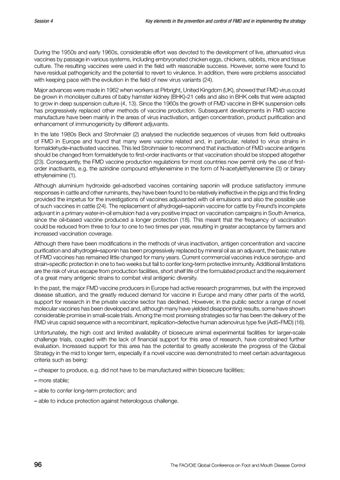Session 4
Key elements in the prevention and control of FMD and in implementing the strategy
During the 1950s and early 1960s, considerable effort was devoted to the development of live, attenuated virus vaccines by passage in various systems, including embryonated chicken eggs, chickens, rabbits, mice and tissue culture. The resulting vaccines were used in the field with reasonable success. However, some were found to have residual pathogenicity and the potential to revert to virulence. In addition, there were problems associated with keeping pace with the evolution in the field of new virus variants (24). Major advances were made in 1962 when workers at Pirbright, United Kingdom (UK), showed that FMD virus could be grown in monolayer cultures of baby hamster kidney (BHK)-21 cells and also in BHK cells that were adapted to grow in deep suspension culture (4, 13). Since the 1960s the growth of FMD vaccine in BHK suspension cells has progressively replaced other methods of vaccine production. Subsequent developments in FMD vaccine manufacture have been mainly in the areas of virus inactivation, antigen concentration, product purification and enhancement of immunogenicity by different adjuvants. In the late 1980s Beck and Strohmaier (2) analysed the nucleotide sequences of viruses from field outbreaks of FMD in Europe and found that many were vaccine related and, in particular, related to virus strains in formaldehyde-inactivated vaccines. This led Strohmaier to recommend that inactivation of FMD vaccine antigens should be changed from formaldehyde to first-order inactivants or that vaccination should be stopped altogether (23). Consequently, the FMD vaccine production regulations for most countries now permit only the use of firstorder inactivants, e.g. the aziridine compound ethyleneimine in the form of N-acetylethyleneimine (3) or binary ethyleneimine (1). Although aluminium hydroxide gel-adsorbed vaccines containing saponin will produce satisfactory immune responses in cattle and other ruminants, they have been found to be relatively ineffective in the pigs and this finding provided the impetus for the investigations of vaccines adjuvanted with oil emulsions and also the possible use of such vaccines in cattle (24). The replacement of alhydrogel–saponin vaccine for cattle by Freund’s incomplete adjuvant in a primary water-in-oil emulsion had a very positive impact on vaccination campaigns in South America, since the oil-based vaccine produced a longer protection (18). This meant that the frequency of vaccination could be reduced from three to four to one to two times per year, resulting in greater acceptance by farmers and increased vaccination coverage. Although there have been modifications in the methods of virus inactivation, antigen concentration and vaccine purification and alhydrogel–saponin has been progressively replaced by mineral oil as an adjuvant, the basic nature of FMD vaccines has remained little changed for many years. Current commercial vaccines induce serotype- and strain-specific protection in one to two weeks but fail to confer long-term protective immunity. Additional limitations are the risk of virus escape from production facilities, short shelf life of the formulated product and the requirement of a great many antigenic strains to combat viral antigenic diversity. In the past, the major FMD vaccine producers in Europe had active research programmes, but with the improved disease situation, and the greatly reduced demand for vaccine in Europe and many other parts of the world, support for research in the private vaccine sector has declined. However, in the public sector a range of novel molecular vaccines has been developed and, although many have yielded disappointing results, some have shown considerable promise in small-scale trials. Among the most promising strategies so far has been the delivery of the FMD virus capsid sequence with a recombinant, replication-defective human adenovirus type five (Ad5-FMD) (16). Unfortunately, the high cost and limited availability of biosecure animal experimental facilities for larger-scale challenge trials, coupled with the lack of financial support for this area of research, have constrained further evaluation. Increased support for this area has the potential to greatly accelerate the progress of the Global Strategy in the mid to longer term, especially if a novel vaccine was demonstrated to meet certain advantageous criteria such as being: – cheaper to produce, e.g. did not have to be manufactured within biosecure facilities; – more stable; – able to confer long-term protection; and – able to induce protection against heterologous challenge.
96
The FAO/OIE Global Conference on Foot and Mouth Disease Control
















